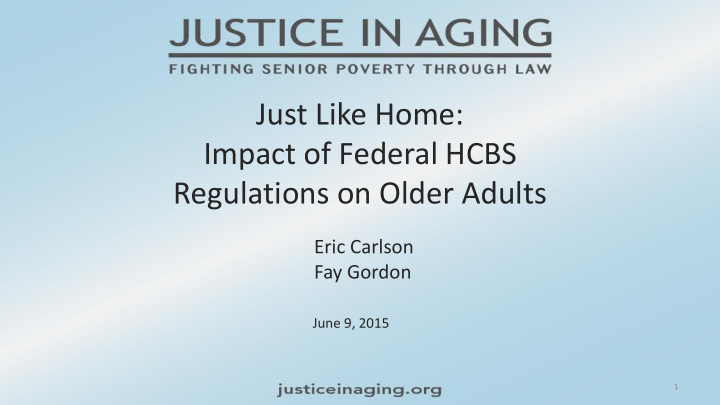



Just Like Home: Impact of Federal HCBS Regulations on Older Adults Eric Carlson Fay Gordon June 9, 2015 1
2
Today Information to help participate in state transition process • Brief background on law and implementation • 5 key areas of interest for aging advocates • Question and discussion 3
Background on HCBS Regulations and Implementation 4
Core Standards, Applying to All Types of HCBS Settings • Integration with Community – Setting must support full access by consumer to community. • Choice – Optimize ability to make life choices. – Facilitate choice regarding services and supports. • Rights – Rights to privacy, dignity, respect, and freedom from coercion/restraint. 5
Standards for Provider-Controller Settings, i.e., Residential Facilities • Additional standards must be met: – Protection from eviction – Privacy rights – Freedom of choice – Right to receive visitors – Physical accessibility 6
Presumed Institutional Environments • State can submit evidence to overcome presumption, but CMS will evaluate with heightened scrutiny. – Sharing grounds with public institution. – Sharing building with nursing facility or other institution. – Has effect of isolating Medicaid HCBS consumers from the broader community. 7
CMS on Intent of HCBS Regulations “ Enhance the quality of HCBS and provide additional protections to individuals that receive these services” 1 • CMS Goals: – Promote community integration – Improve choice among residential and non-residential settings – NOT a goal: shut down provider types 1 Centers for Medicare and Medicaid Services, Home and Community Based Services, available at , http://www.medicaid.gov/Medicaid-CHIP-Program-Information/By-Topics/Long-Term-Services-and-Supports/Home-and- Community-Based-Services/Home-and-Community-Based-Services.html. 8
States’ Transition Plans Will Take Years to Implement • 2014-2015: States submitted initial transition plan • 2015: CMS reviewing initial transition plans • 2015-2019: CMS, states and stakeholders work together throughout review and implementation: – CMS review for: stakeholder engagement, policy assessments, site- specific assessments, remediation, monitoring and compliance 9
Info on Medicaid.gov http://www.medicaid.gov/Medicaid-CHIP-Program-Information/By-Topics/Long-Term-Services-and-Supports/Home-and-Community-Based-Services/Home-and-Community-Based- Services.html 10
Additional Resources on HCBS Rule http://justiceinaging.org/wp-content/uploads/2015/06/Just-Like-Home-_-Federal-HCBS-Regulation-Impact-on-Older-Adults.pdf 11
Additional Resources 12
5 Key Areas of Interest for Aging Advocates 4
1) Assessing Settings 2) Community Integration 3) Protections Against Eviction 4) Alzheimer’s and Dementia -Specific Issues 5) Application of Regulations 4
1) Assessment a. Solicit and consider input from participants • Overreliance on provider input Watch For • Failure to obtain input from non-state sources • Participant input through participant Recommend interviews 6
Limitations of Provider Input • Consumers are better able to identify what feels home-like. • Providers have incentive to not identify their own settings’ non -compliance. 6
Do Providers and Consumers Evaluate Settings Differently? • Indiana surveyed case managers and consumers for DD waiver. – in 7 of 8 categories, consumer survey showed non-compliance (<85%) while case manager survey showed compliance. • The 7 categories: Visitation, control of schedule, choice of services & providers, community access, control of personal resources, opportunity to be employed, & integration with broader community. 6
1) Assessment: b. Conduct onsite assessments of settings • No onsite assessment in assisted Watch For living facilities • Paper compliance determination • On-site assessment, including Recommend participant interviews 6
2) Community Integration: a. Full access to the community • Contact with non-Medicaid-funded Watch For participants accepted as integration • Integration with the community Recommend outside of the setting 6
2) Community Integration b. No payment source discrimination • Protections limited to consumers who Watch For receive Medicaid funding • Advocate for consistent application of Recommend standards to all consumers 6
2) Community Integration c. Careful consideration of setting characteristics • Blanket approval of settings inside nursing facility buildings as HCBS Watch For • Take heightened scrutiny requirement seriously • Provide evidence of how setting Recommend meets each requirement 6
Poll: Should HCBS Medicaid Funding Ever Be Allowed for Residential Facilities Co-Located with Nursing Facilities? • No, never. • Yes, provided that integration with the community is facilitated in other ways. 6
3) Protections Against Eviction Eviction protections for assisted living residents • Failure to recognize complexity of establishing landlord-tenant Watch For protections • Detailed strategies for implementing lease and eviction protections Recommend • Standardized templates • Revised state licensing requirements 6
4) Alzheimer’s and Dementia -Specific Issues a. Addressing “secure” settings • Failure to address the issue of “secure” units Watch For • State engages consumers and providers to determine how to Recommend comply with regulations for persons with dementia 6
Some States Seem Too Quick to Approve Funding in “Secure” Settings • Virginia’s Alzheimer’s Assisted Living Waiver Draft Plan – Transition plan states broadly that “[ i]ndividuals require safety mechanisms regardless of the setting they are in to prevent wandering (therefore use of secured units or buildings is necessary).” • New Jersey – Transition plan states that locked units are critical part of HCBS settings, with expectation that placement in locked HCBS unit could be justified by service plan. 6
Responding to “Secure” Settings • The issue of “secure” settings deserves honest debate. – Use of “secure” settings should not be assumed; the state and stakeholders should discuss the issues. – At a minimum , secure settings should be considered settings that tend to isolate, and CMS should consider use of those settings under heightened scrutiny review. 6
Poll: Should HCBS Medicaid Funding Ever Be Allowed in “Secure” Settings? • No, never. • Yes, provided that integration with the community is facilitated in other ways. 6
4) Alzheimer’s and Dementia -Specific Issues b. Privacy rights • Disregarding privacy rights of persons with dementia Watch For • Recognize value of privacy and calm Recommend environments for all residents and participants 6
5) Apply regulations to all HCBS services HCBS funded through different mechanisms • Failure to apply HCBS rule protections to state-plan-funded services, like Watch For adult day services • Transition all HCBS programs into Recommend compliance with HCBS regulations 6
More information available in the issue brief: http://justiceinaging.org/wp- content/uploads/2015/06/Just-Like- Home-_-Federal-HCBS-Regulation- Impact-on-Older-Adults.pdf 26
HCBS Rule Offers Promise for Older Adults; Stay Involved in Your State Transition Process Thank you Eric Carlson, ecarlson@justiceinaging.org Fay Gordon, fgordon@justiceinaging.org 31
Recommend
More recommend